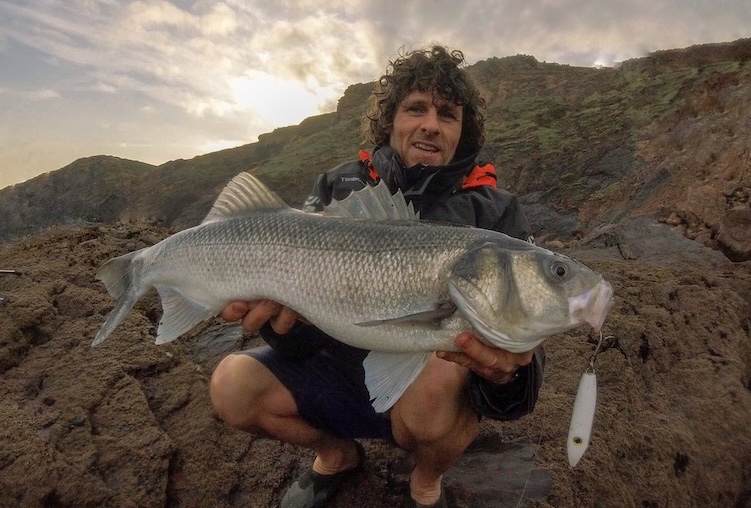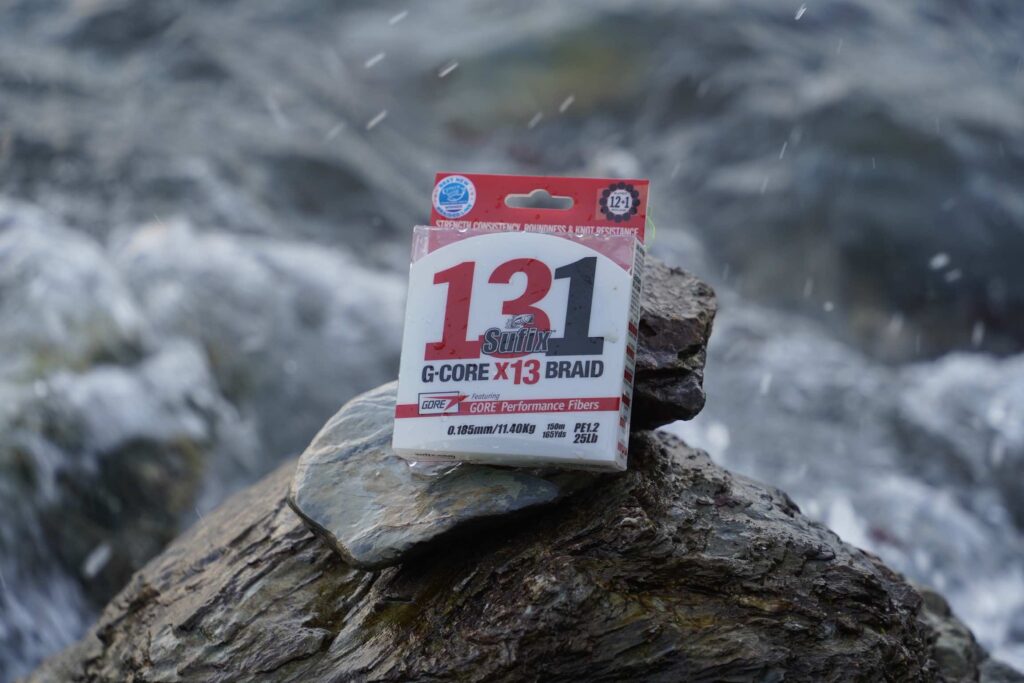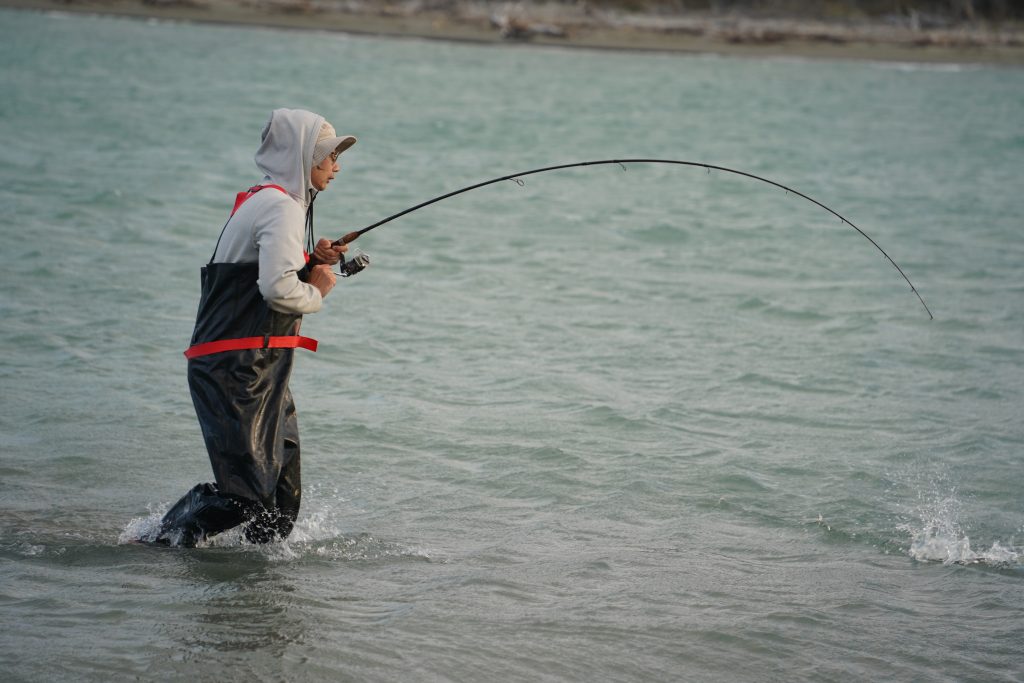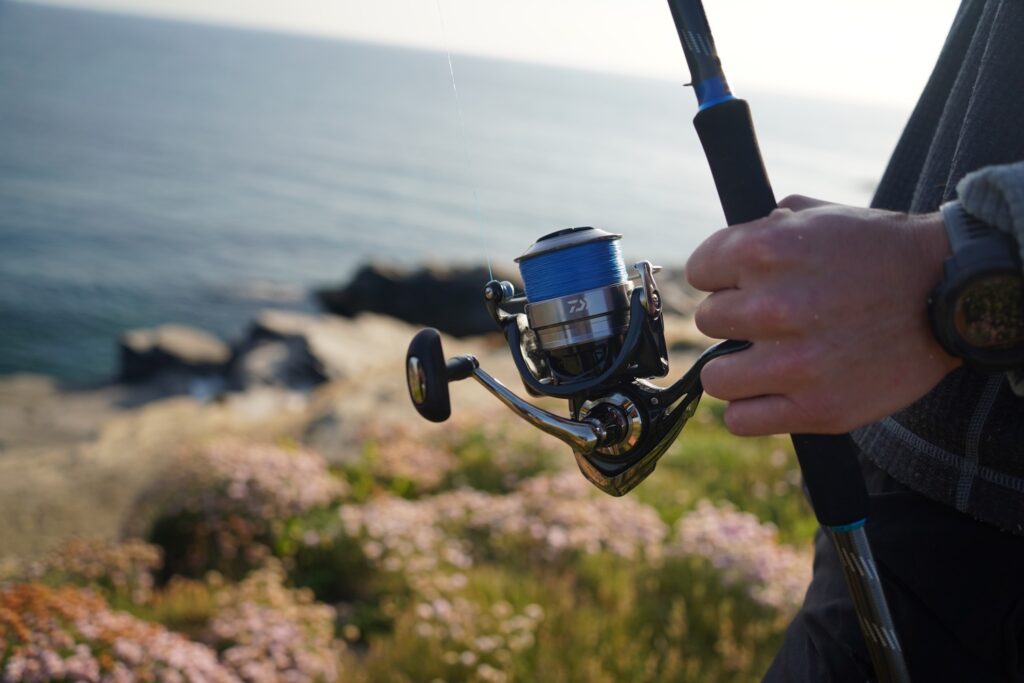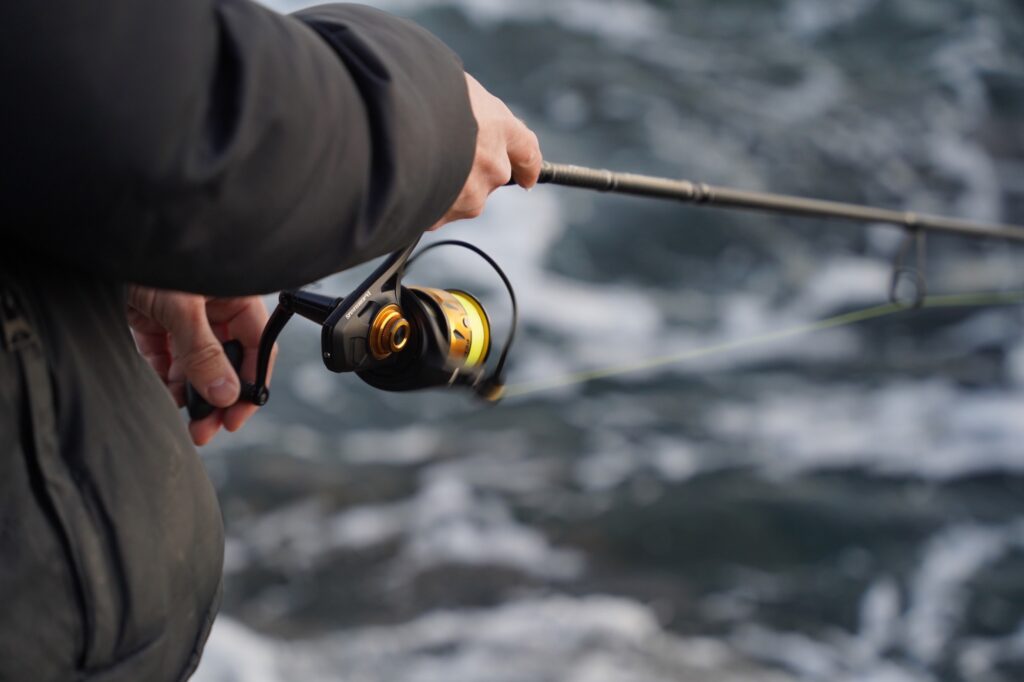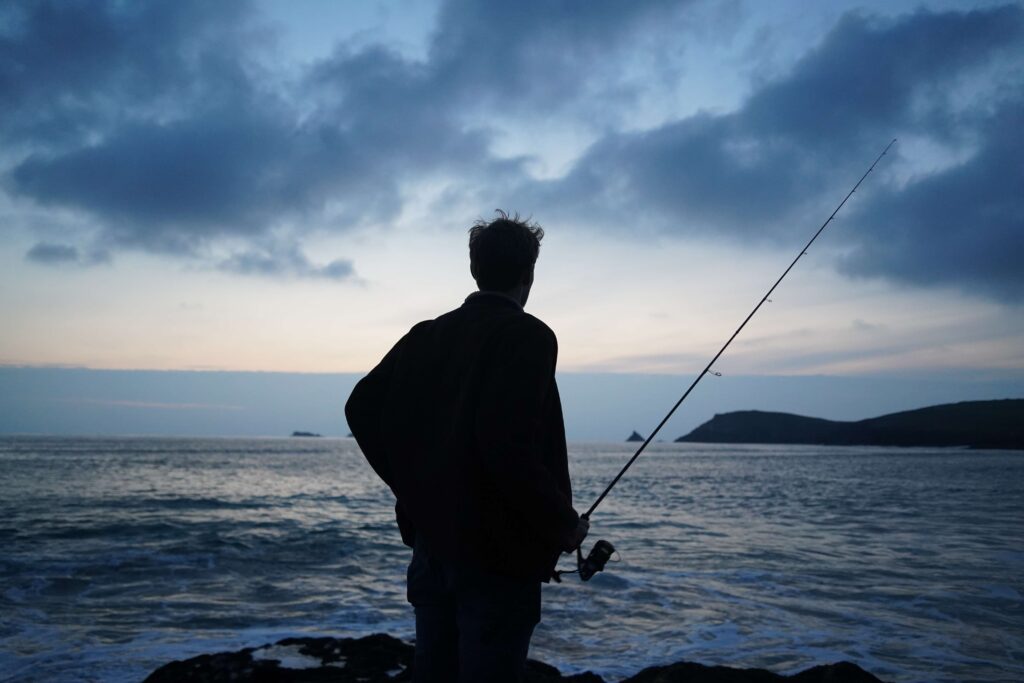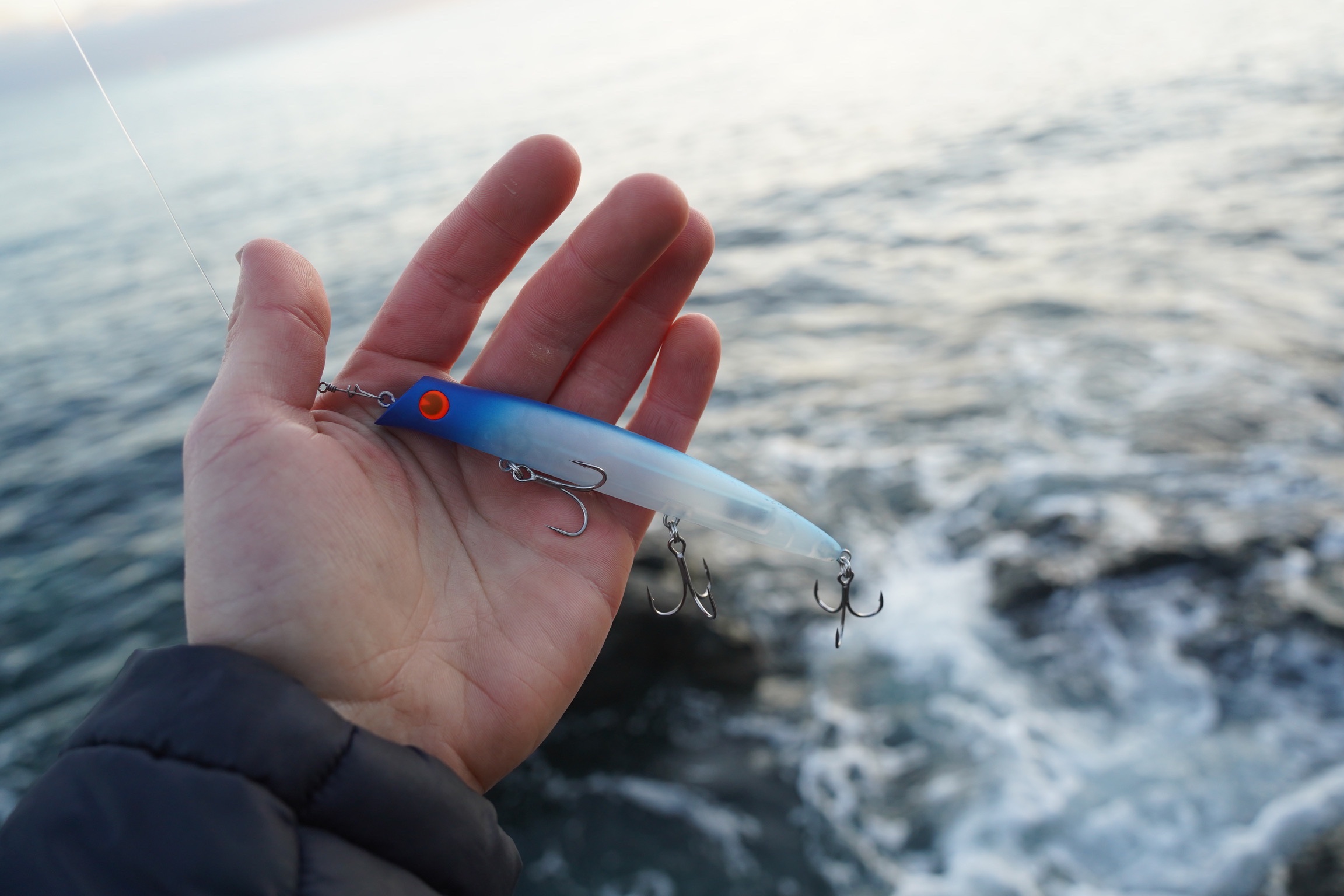
The UK’s Best Bass Lures
Let’s start by looking at the three bass lures that will cover you in every fishing situation. Then, let’s break down every bass lure by type and highlight some of the best bass lures for UK sea fishing along with when and how to use them.
This page contains product recommendations to Amazon from which fishmag earns commissions.
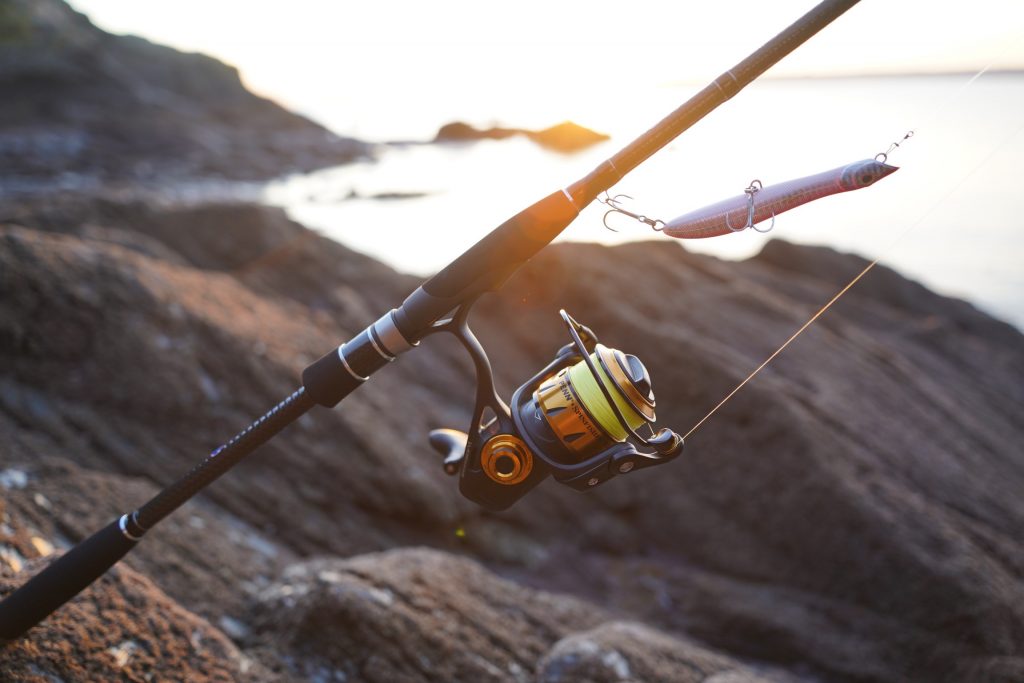
We recommend checking the legal landing size for bass here and picking up some basic disgorgers for unhooking fish quickly without hooking yourself. It’s a common beginner mistake not to bring these. A wet towel is also helpful to avoid getting spiked and protects the fish from rocks.
Three Bass Lures that Cover Every Scenario
The best deals on bass lures in the UK are generally online. These three lures cover most scenarios.
1. If we could only own three bass lures, We’d start with a good weedless paddle tail like the Fiish Minnow. This lure avoids snags over rough ground and works everywhere.
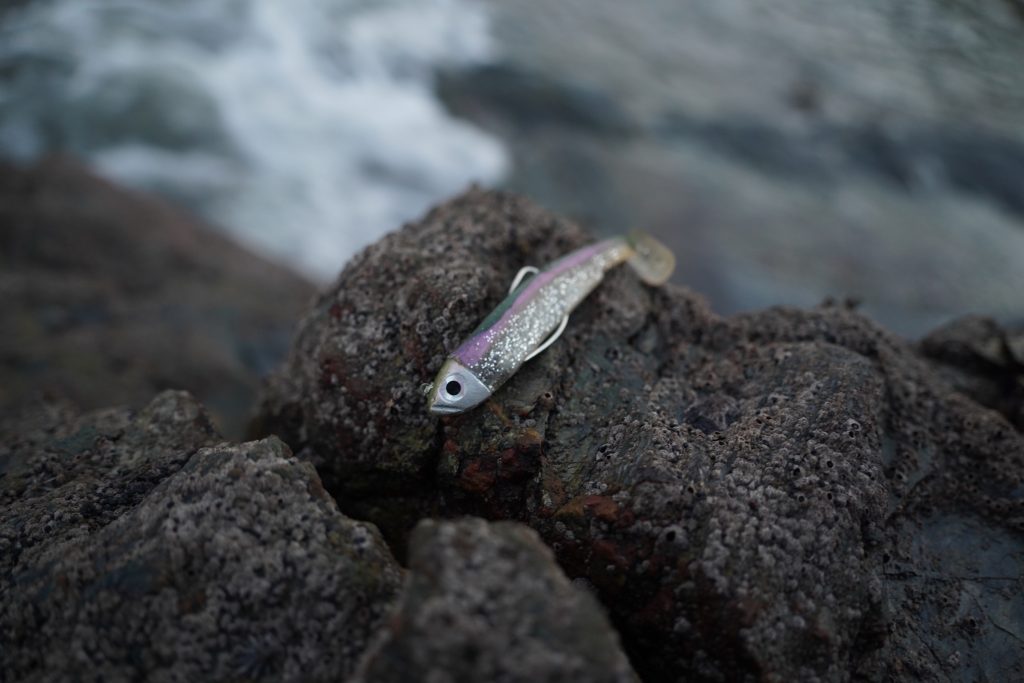
2. Secondly, we’d grab a long-bodied metal lure or pencil. This will cast a long way so you can search the water quickly for fish, even in the wind. Bass don’t tend to hit smaller metals.
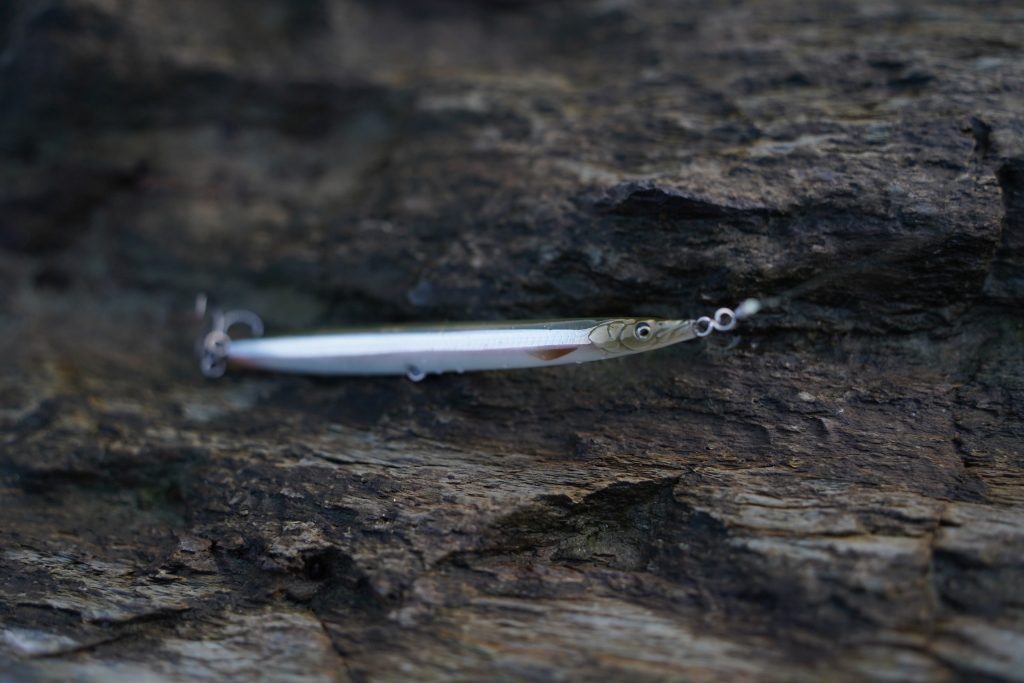
3. Finally, we’d have a Patchinko surface lure. This is the most popular surface lure for catching bass in mid-late summer when they’re feeding near the surface.
This covers all your bases for bass fishing from the shore, be it from a rock, beach or estuary. Now you’ve got your staples. If only we could stop there…
The best bass lures imitate what’s around
The diet of the British sea bass is the stuff of a Frenchman’s dreams; a varied seafood feast. Bass are eating things that are fast, slow, thin, fat, round, silver, red, green, blue – the list goes on. There are many types of lures that work, and we will cover them all in this article. Ideally, you’ll work out what the bass are feeding on by observing the birds etc to see what’s around. It’s handy to have several different types of bass lure in your box, so you have your options open on the day.
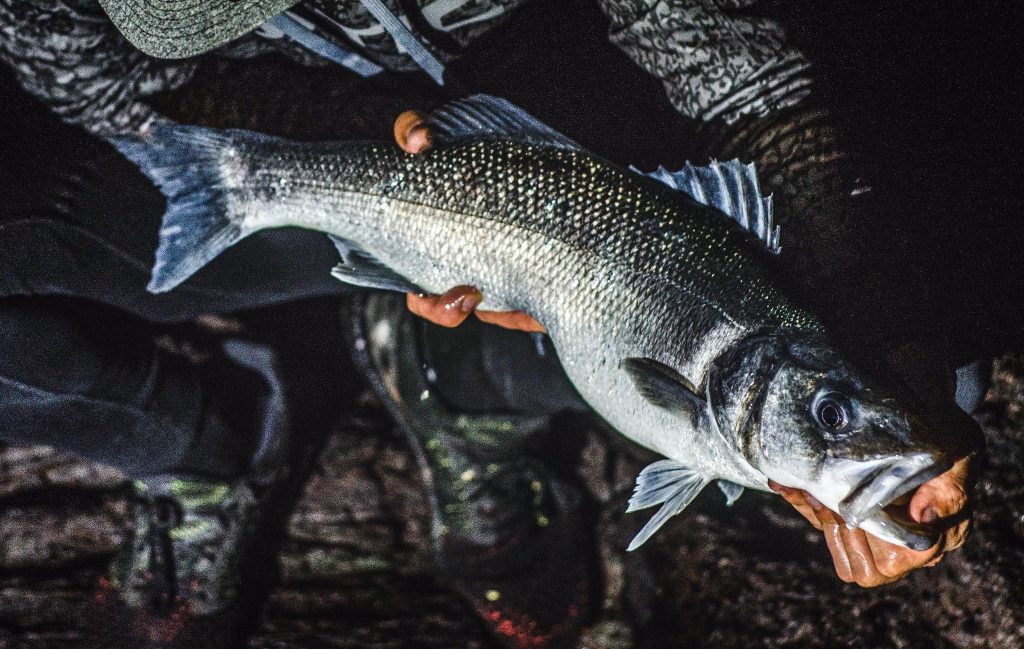
What do bass eat?
SANDEEL: Bass also feed on glimmering shoals of sandeel. These flash like long pieces of metal. Note that silver shrimp mackerel feathers rarely catch bass despite imitating sandeel well. This is because the lead weight ruins the lure presentation and the silver shrimp are too small. Also, there are four hooks on that rig, so there is no clear isolated target. Predators like bass love an isolated target, which is partly why they hit lures even when thousands of bait fish are around.
LIL’ POLLOCK: They also eat small pollack and other white fish. These small fish spend most of their time lingering motionless above the kelp. They are white with a dark red-orange or pinkish hue. Weedless weightless rigs can imitate the suspended, delicate movements of these fish.
SMALL CRABS: Bass engulf crabs and soft-shelled peelers are their favourite. These crawl slowly on the seabed and hide amongst the rocks. They come out just after the tide covers rocky areas. So, we know that bass are expecting food to be on the bottom. They are also expecting food as soon as the tide has covered a new area of shallow ground.
SQUID: At night, bass feed on ‘squads’ of squid. Squid are far more present in UK waters than most anglers realise. They are mostly white or red. They move in sudden bursts of jet propulsion. When they don’t move, they don’t sink, they are suspended in the water! The best lure to imitate a squid is a needle lure. You might think a good squid imitation would look like a squid, but the overall profile and movement of the lure is more important than details like tentacles!
OILY FISH: Bass eat pelagic oily fish that roam the open seas, like mackerel, sprat, herring and sardines. These fish are often in the middle or upper sections of the water. These oily fish are constantly moving, and swim at about 14km per hour, which is faster than we can reel in a lure. We imitate these with bass plugs and have different types for swimming to different depths. Most people own a selection so they can search the whole water.
Some top-picked bass lures
Handy kit for fishing weedless, premium lures for rough shallow ground
UK’s most popular surface lure, worth the price for warmer months & snag proof as doesn’t sink
Most popular high end shallow diver, knows its price unfortunately
Savage Gear Sandeel, much more versatile that the straight tail weedless lures
Bass plugs
Plugs are sold as shallow divers, medium divers, deep divers or surface lures. There are also sinking bass plugs and floating plugs. Bass hunt throughout the water column and go where the food is. You need shallow divers and surface lures to be able to fish over shallow rough ground and you need deep divers to plumb the depths.
How do bass plugs work?
Plugs often have ‘lips’ which poke out in front of the lure that sets the dive depth. If you retrieve these lures faster, they swim deeper. Do nothing, and they float. If you hit the seabed and are about to get snagged up, you can often stop retrieving and your lure will float away from the snags. Bass often hit lures when you stop retrieving for a few moments. These moments are only possible over shallow rough ground because the lure floats.
What size lure is best for bass fishing?
Most popular bass lures are between 3-5″ (about 12cm). The best size bass plug for you will depend on the casting weight of your rod. If your rod is rated to 28g, fishing with 18-21g plugs is a good idea. Because plugs create a lot of resistance in the water as you retrieve, it’s important to choose lower weights than your rods maximum casting weight. Otherwise, softer-tipped rods will bend too much on the retrieve, reducing bite sensitivity and your ability to control your lures presentation.
When water clarity is poor, avoid using your smallest lures as they are harder for bass to see.
Surface lures
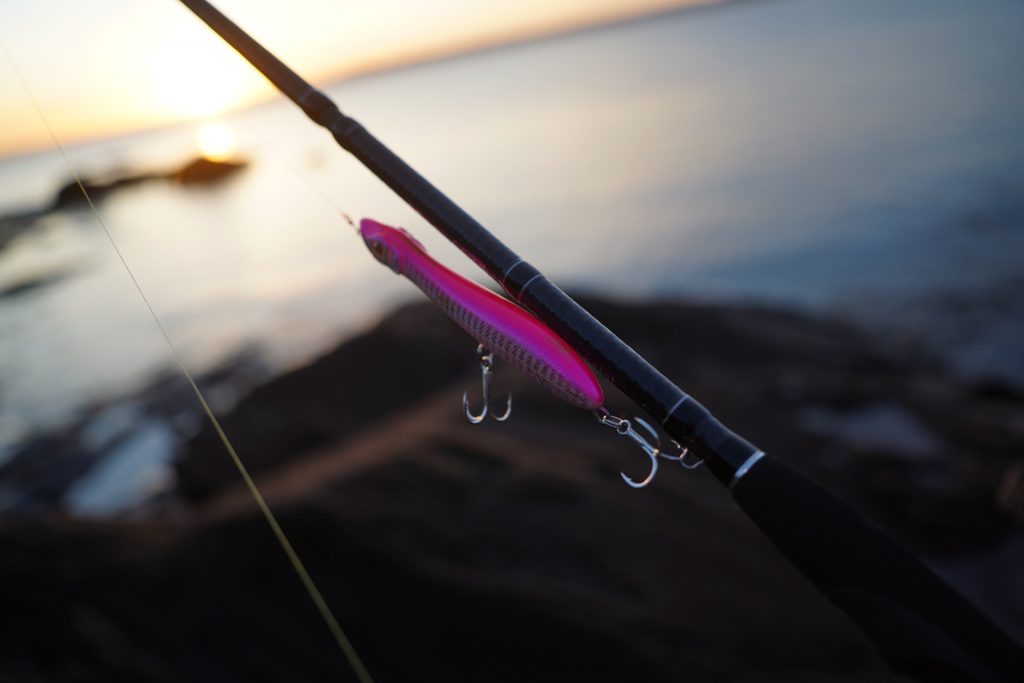
There are two main types of surface lure – poppers and walk-the-dog style lures. Both usually have concave faces that spit water as you retrieve them. The difference is that poppers are designed for a straight retrieve. Sliders are designed to be twitched back from left to right in a zig zag across the water’s surface. Often, poppers are very short and fat and sliders have long bodies. Since most bait fish in the UK have long bodies, sliders like the Pachinko or the Savage Gear Surface Walker are the best surface bass lures for the UK.
Surface lures are also amongst the best bass lures in the summertime
Surface lures (top water lures) are most effective when the water is warmer and the bass are in the habit of smashing fry from the surface. If you’re fishing over new ground or ground that you know to be snaggy, a surface lure is often your best bet. They are also most effective around dusk and dawn and are extraordinarily fun to use.
Many anglers only use poppers on clear, calm days. They think that bass can’t locate surface lures in slightly choppy, clouded water. But bass can hone in on a black lure in murky water in the middle of the night. On clear days, you can retrieve faster to trigger impulsive hits. It’s often best to leave your lure for 10-20 seconds mid retrieve and just after casting. So many hits come when you stop retrieving. This is especially important in cloudy water.
The two best topwater lures UK
Xorus Patchinko – The Best Surface Lure
The Patchinko is undoubtedly the UK’s best surface lure and has been for years. I’ve been recommending it for years and still do today. It combines the best of poppers with the best of walk-the-dog style lures. It does everything all in one killer lure (to rule them all). Available at Veals here.
What size Patchinko should I get?
The Patchinko comes in 5 different sizes – starting at 85mm and 7g, going up to 165mm and 45g. The most common sizes used are the Patchinko II 140 and the 125. The biggest 165mm lure would be better for rougher conditions targetting bigger bass, whereas the smaller 100, and 85mm models would work better on calm estuary fishing.
Savage Gear’s Surface Lure – The Sandeel Surf Walker
If you’re looking for a surface lure that allows you to cover more ground than the Patchinko, then the Savage Gear Sandeel surf walker is the best surface lure for you. This is a walk-the-dog style lure that is designed for fishing in surf (just behind the waves where the bass lurk).
Savage Gear sandeel surf walker – on amazon or from Veals.
Shallow diving bass plugs
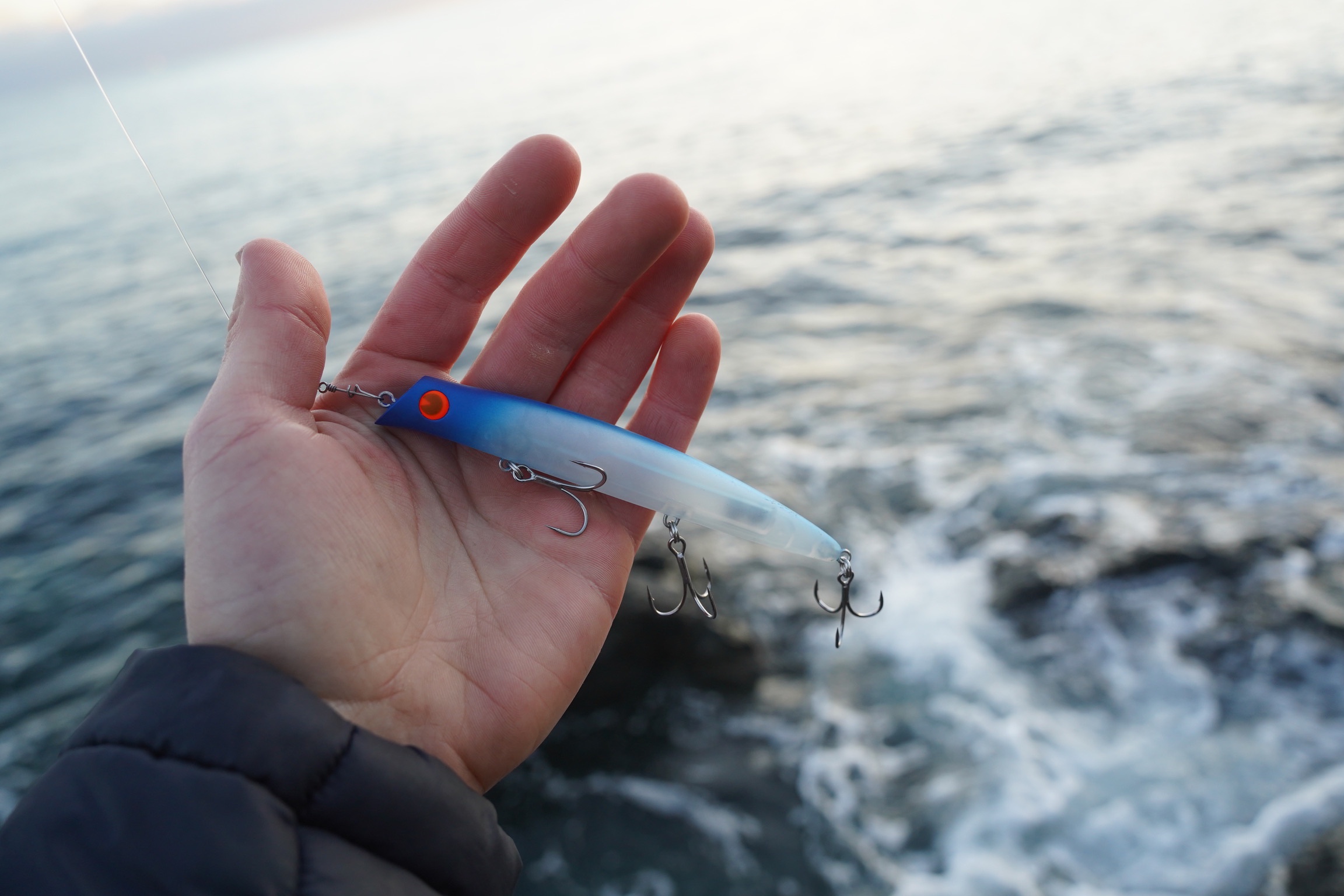
Above, the Original IMA Komomo – also available here. A hugely popular shallow diving bass lure
Shallow diving plugs are the most commonly used when shore fishing for bass in the UK because generally bass fishing is done over shallow rough ground, and these lures enable you to fish it without getting in so many snags. It’s also convenient that the smaller lips on shallow divers enable them to be cast further.
The depth a plug dives to can affect which colour is best, based on the colours of bait fish that tend to swim at the depth you’re fishing. When you’re fishing in shallow water with shallow diving plugs, colour is probably more of a factor than when fishing in deeper water. This is because your lure is at eye level with the bass, rather than a silhouette above it.
You might consider having one shallow and medium diving silver / white plug for imitating juvenile mullet or lance over clean ground and another for imitating darker coloured fish like gobies over shallow rough ground. Consider, when have you ever seen a goby swimming near the surface over sandy ground?
Tackle House Feed Shallow Diver
A legendary shallow diving bass lure is the Tackle House Feed Shallow. It has gained a reputation as one of the most reliable and high-performing bass lures out there. If new to fishing, I recommend checking the size is what you need before you order.
Lures like this can be twitched back, retrieved and then paused or simply cast out and given a steady retrieve. Even among experienced anglers, there is a lot of variation in how people work their lures. I like a steady retrieve with sporadic pausing.
There are a few available here.
Duo Tide Minnow
This lure is designed for surf fishing for bass and despite being a shallow diver, allows for a bit more depth control than many other bass plugs. Change your retrieval speed and how long you let the lure hang to alter the depth.
IMA Hound
One of the most popular shallow diving bass lures ever made – it dives to around half a metre, give or take 15cm. Get yours here. This is the larger size, which will give you the best casting distance on a standard bass rod.
Deeper diving and sinking plugs

I would recommend having a medium-depth plug that’s silver or bright coloured, to imitate sandeel and launce when fishing in open water. These fish are often in the upper middle section of the water column, which is reachable with plugs that dive about 1-2m. Fish that have natural colours, browns and greens, rarely occupy this section of the water column. This is a personal preference of course.
Deeper diving plugs in natural colours allow you to imitate small wrasse and pollack which lurk close to the seabed. However, in murky conditions or at night, white is popular for creating contrast, enabling your lure to reflect whatever light is present. The colour white is not a specific light wavelength, it’s a collection of all visible lightwave lengths. As the water gets deeper, fewer colours are visible. This means the white lure is capable of reflecting whatever light is around in lower light conditions.
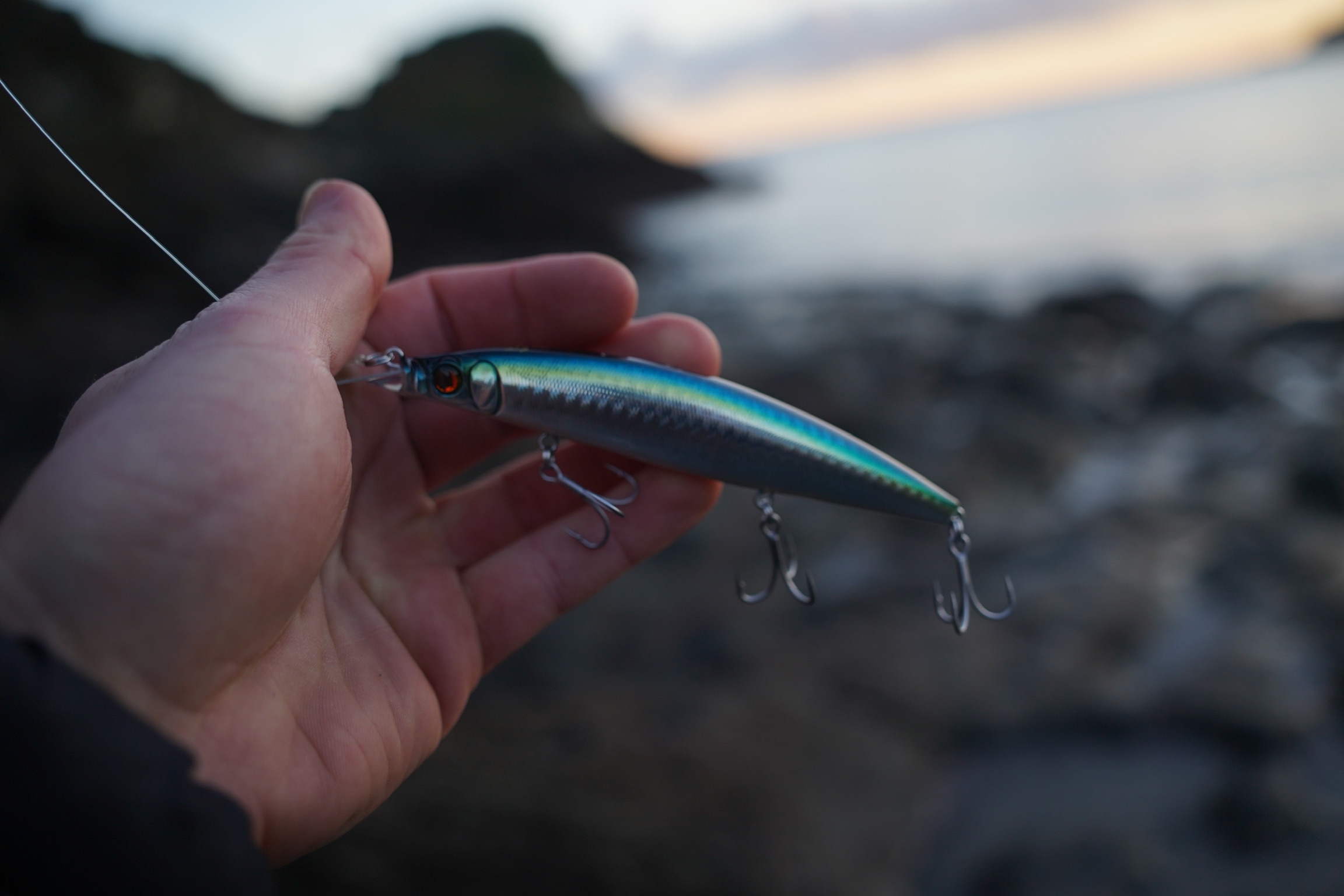
Megabass Zonk
The best sinking bass plug
The Megabass Zonk has been a staple for bass anglers for years and remains so. It dives to about 2m on retrieve and so is useful for fishing near the bottom over shallow sandy ground or else to get properly subsurface when you’re fishing in a surf and shallow divers can’t get a grip. The lure has a very premium build and weight transfer system so it will cast substantially further than cheaper imitations. This is all reflected in the price, but one way to fish with expensive bass lures without grimacing is to just use a lure like this over sandy ground or water that’s consistently deeper than 3-4m. Then, you can keep one of these for years in your tackle box.

The Ultima Artist Swimmer 105mm Sinking Minnow
This is insane value for money. It’s listed as a sinking lure rather than a deep diver, however in reality it is a shallow diving lure when you buy a value-version of it. The original is ideal when fishing over deeper water for bass, particularly if kayak fishing for bass. This version is better for fishing in very shallow waters where it will dive about 1ft beneath the surface. It’s insane value for money, but as I mentioned above, you can’t expect identical performance to the originals.
View artist swimmer
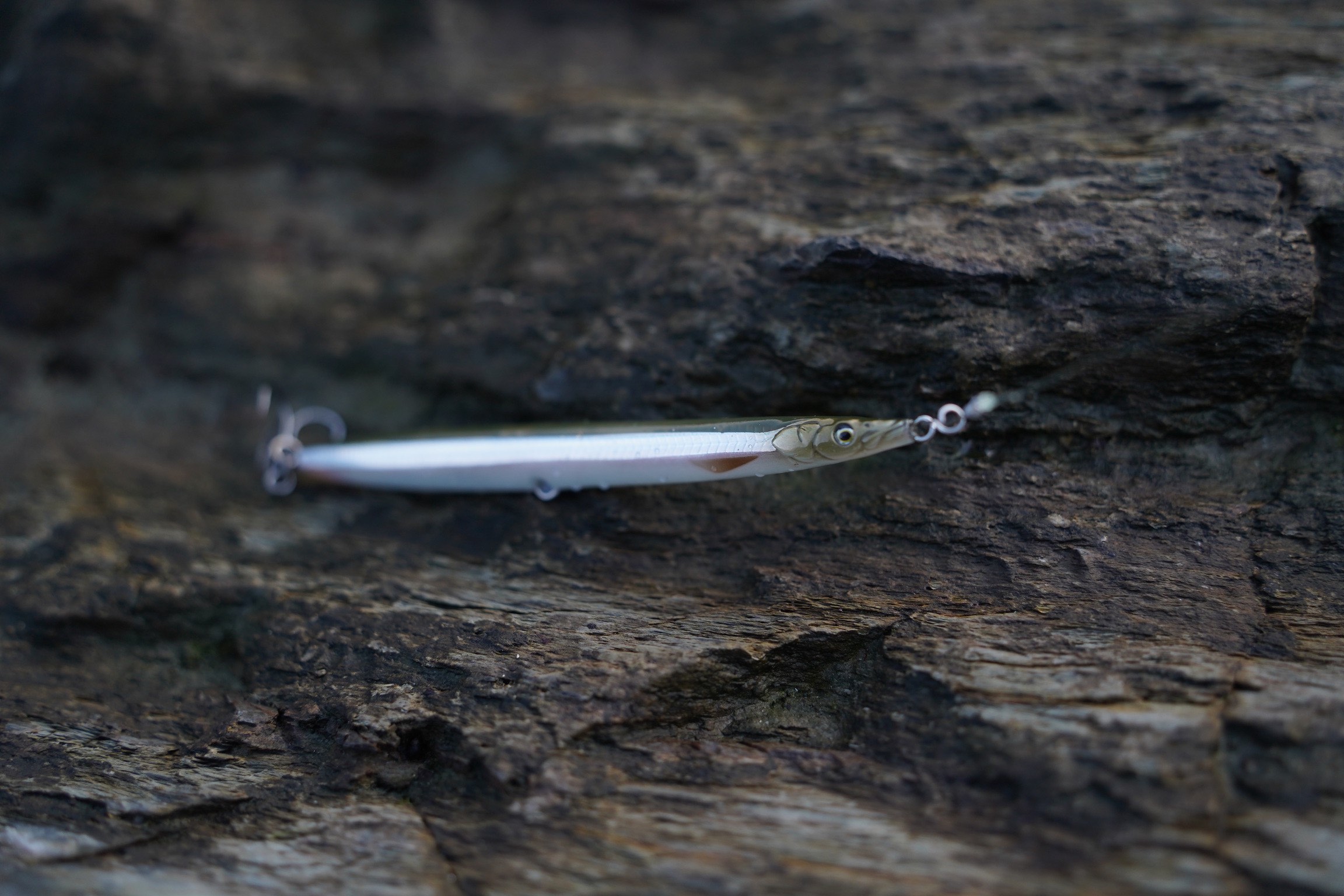
Pencil & Needle Lures
Pencils and needles are pretty specialist bass lures and refer to actionless lures with a cigar-shaped profile that sink relatively slowly, due to being made from wood or else designed to sink slowly. They are also often designed to suspend parallel with the water’s surface – rather than diving down head-heavy and up head-raised. They are popular for fishing in areas with lots of current, which is why they were developed originally in Jersey by the bass guides over there. They are also popular for bass fishing at night. It’s thought that their success may be owed to the way they move with the water in a current and because they might look a lot like squid, which can be plentiful in British waters at night and are a popular meal for bass. The pencil lures are much thinner and more sandeel like.
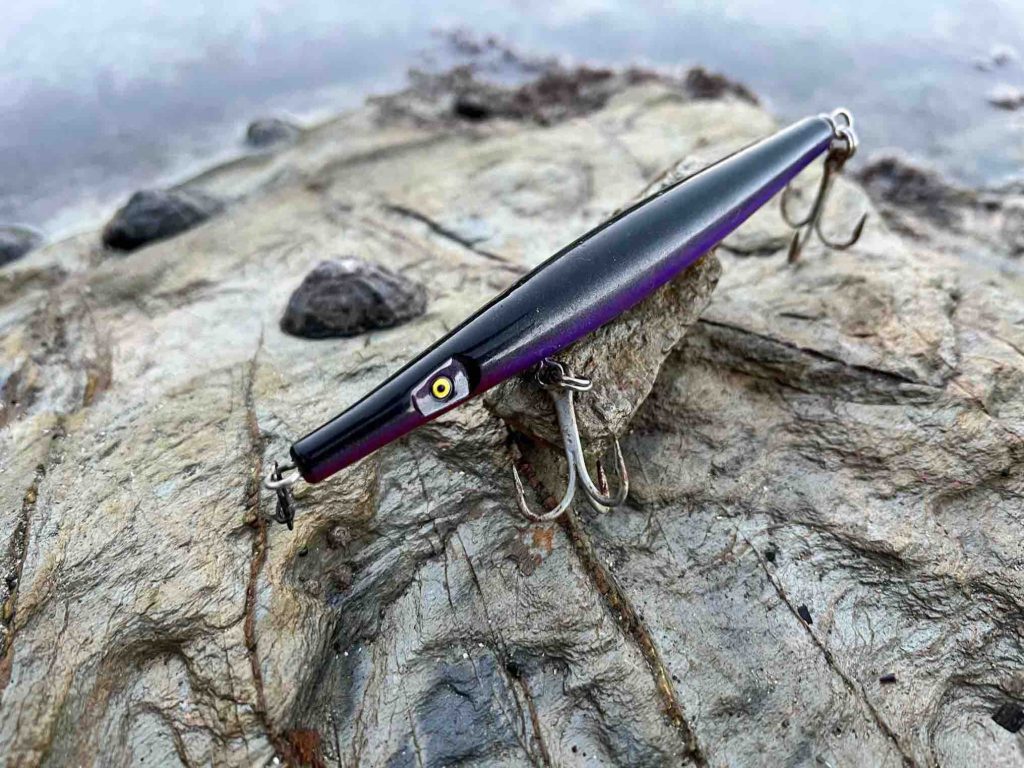
Rapala lures
The American bass fishing scene dwarfs the scene we have here in the UK.
A lot of the crank baits – which are basically short fat plugs – would not be well suited to fishing for sea bass in the UK. But somewhere amongst the jitterbugs, top water baits, jointed swimbaits, blade baits, suspended jerk baits etc – there will be lures that work magic in our waters too.
Rapala has earned a name worldwide as a maker of reliable lures, and one you should check out for applications to your bass fishing is the Rapala X-Rap – aimed specifically at saltwater anglers. This lure is often found in a size just over 40g, which is too heavy for most UK shore fishing for bass but a great option for those using a more traditional spinning rod that’s 9-10ft long and casts 60g (1-2oz).
View Rapala X-Wrap – conveniently without treble hooks for easier unhooking of bass.
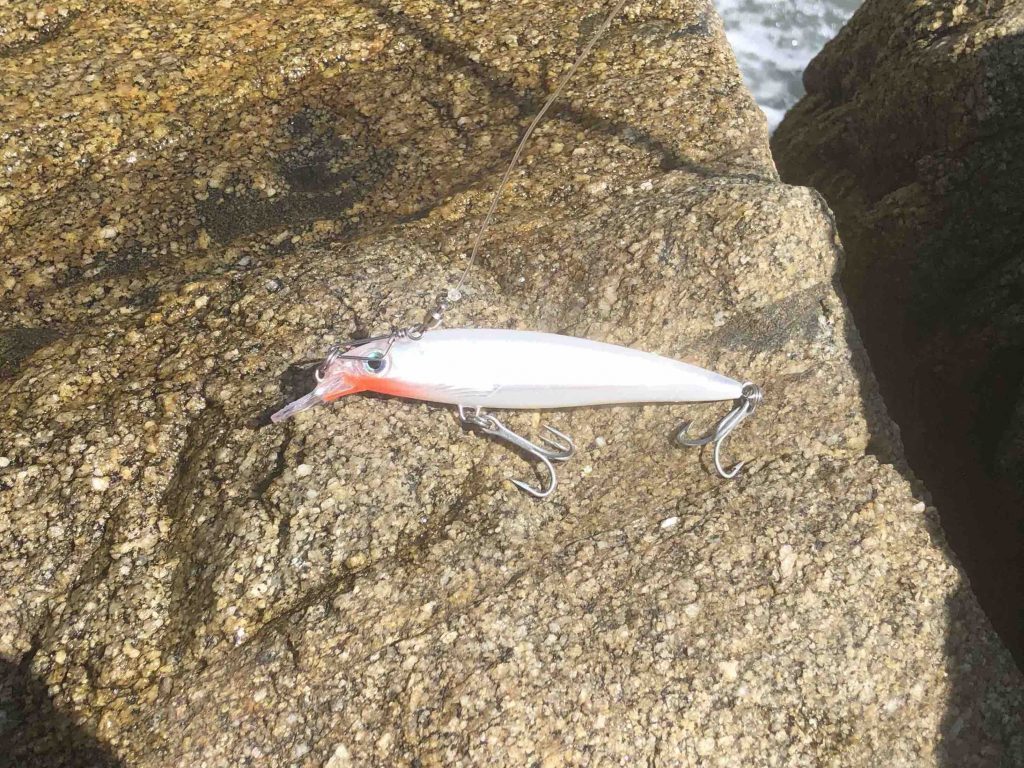
Soft plastic bass lures
There are three main types of soft lure. Paddle tails – which swim. Curly tails – which have a weird spinning movement. And straight lures – which don’t swim and have straight bodies. We will go through these different types and when to use them here.
What are soft plastic lures?
A soft plastic or soft lure is a term for lures made from plastic that are supple enough to bend between your fingers. This allows them to move in the water like baitfish. These lures are often lower cost than plugs, particularly when rigged on a simple texas rig. More commonly, soft plastics are rigged on jig heads.
Paddle tails
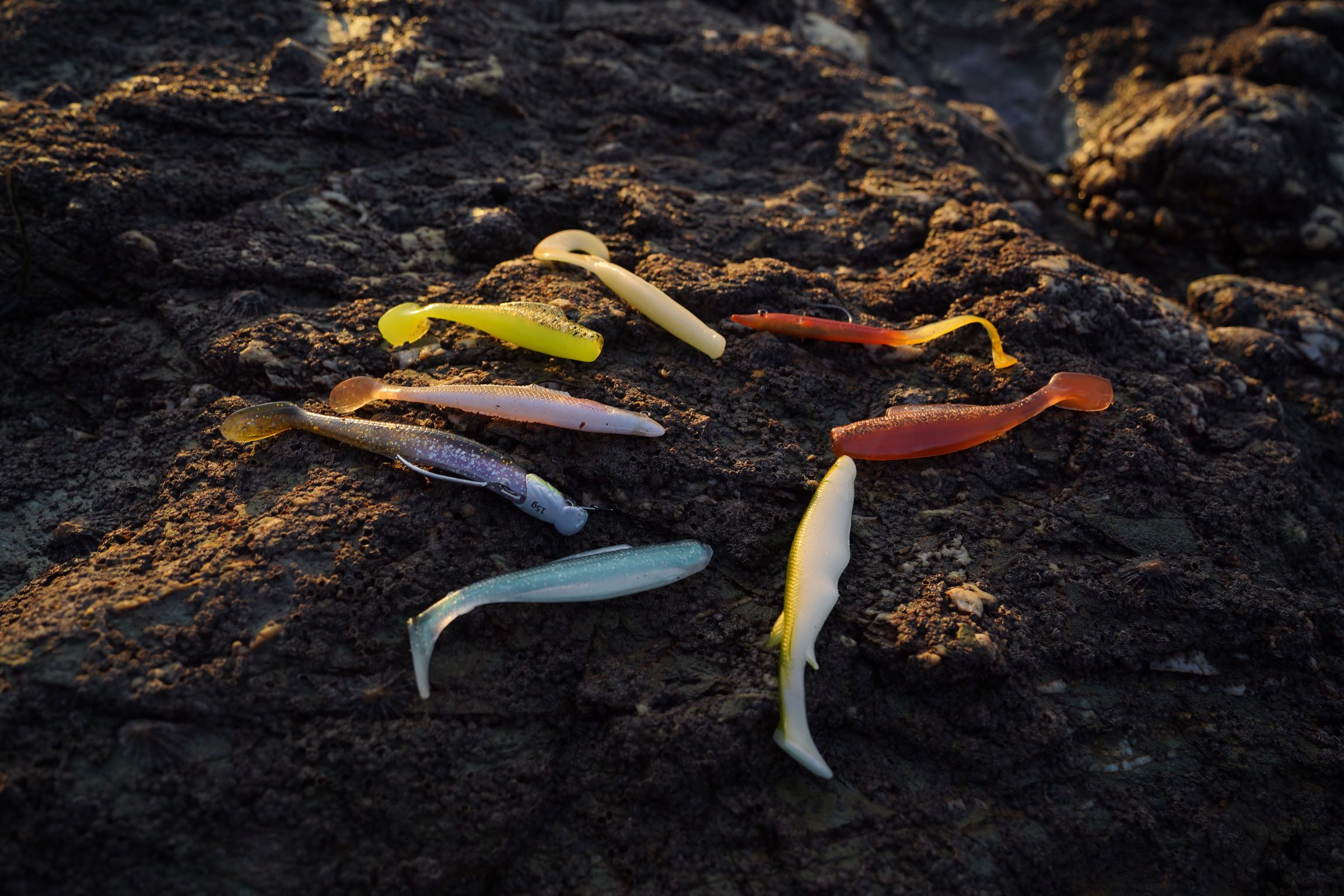
Let’s begin with the classics and then get to the best modern soft plastics. Then we can see how and why paddle tails have changed over the years, which will help you assess soft plastics you see in the future in terms of usefulness.
The Early Days & Red Gill Lures
The early soft plastics include designs like the Red Gill (below), which was invented in Mevagissey, Cornwall in the 1950s. It has been enduringly popular, in thanks part to its hyper-realistic movement as well as its toughness.
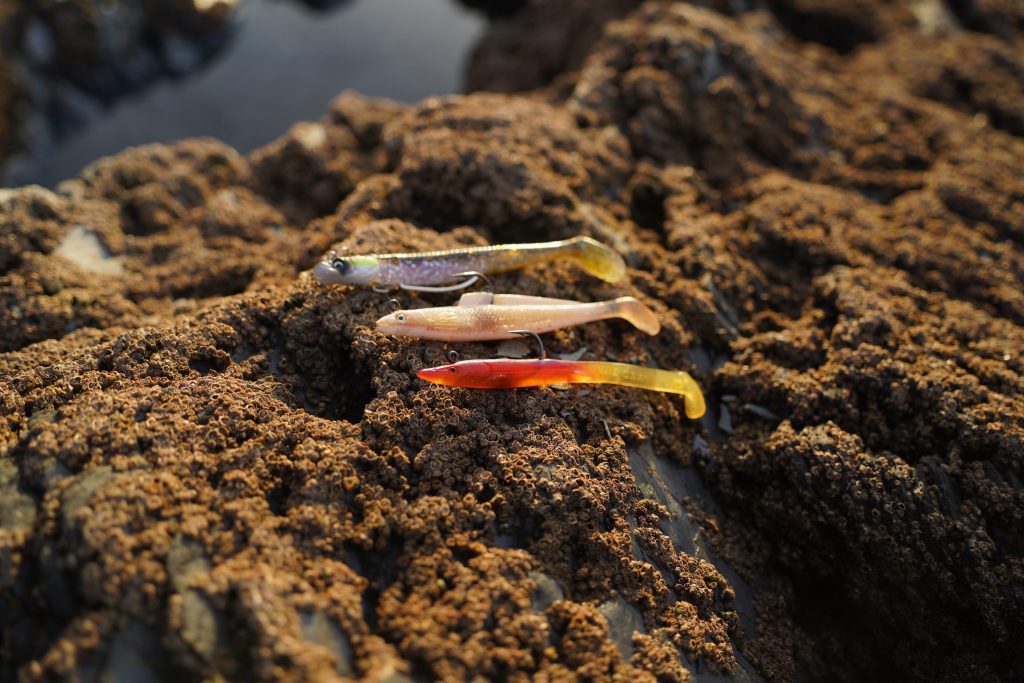
The Sidewinder
A paddle tail soft plastic developed in more recent decades is the Sidewinder sandeel. This has a shorter, fatter body than the Red Gill and imitates a small round fish more than a sandeel. Its thicker profile increases the lure’s visibility.
The Sidewinder in the red and yellow colour ‘(Rhubard and Custard’) (red and yellow) is hugely popular when boat fishing for cod and other members of the cod family like pollock and ling. The design is not weedless but the material is very durable and tough. Veals has a special colour set of three lures just for bass.
View Sidewinder on Amazon or Veals or Angling Active
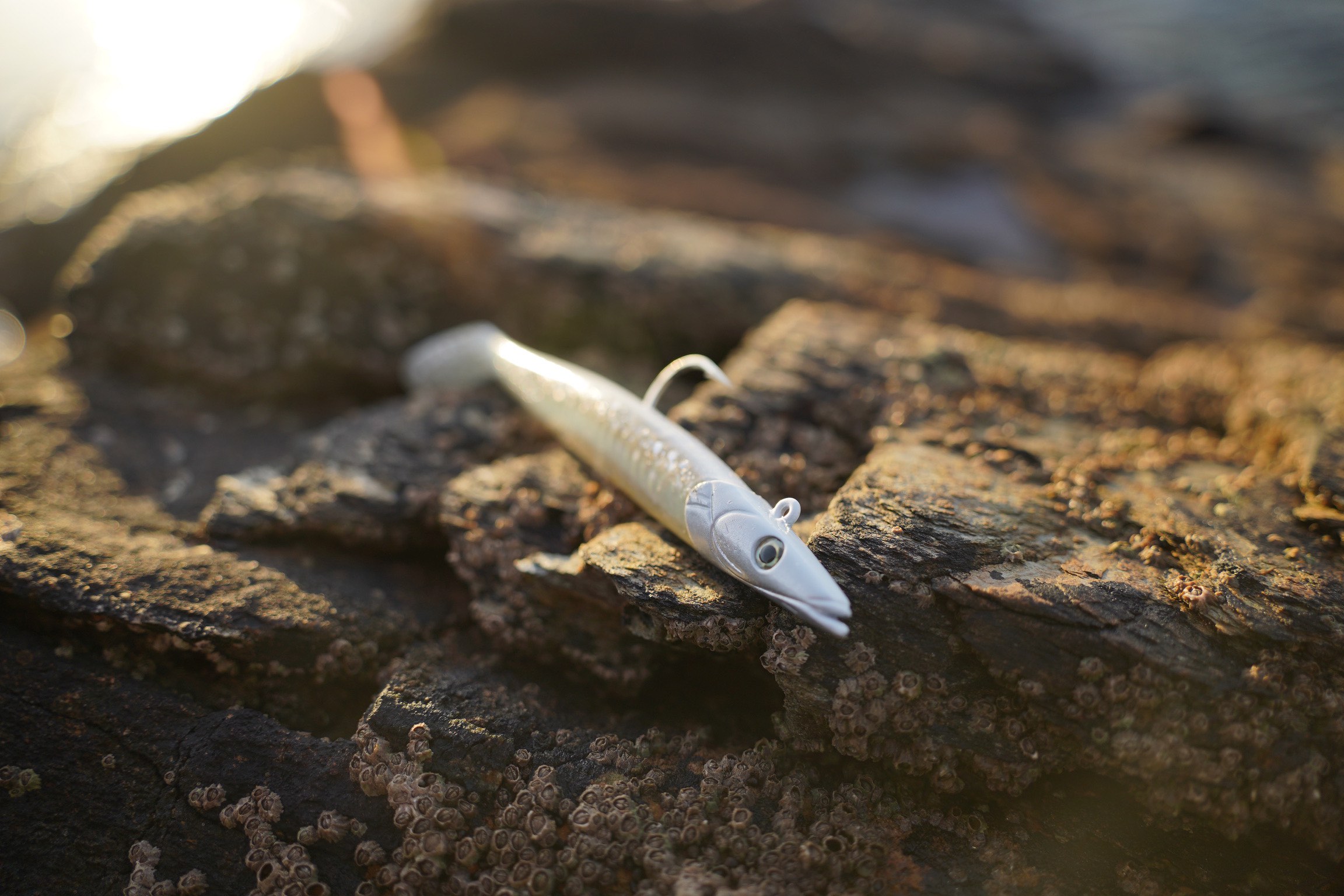
Savage Gear Sandeel
Then came the Savage Gear Sandeel. It’s become a modern classic. The main improvements made on a Sidewinder are the superior hook quality, movement and better design for casting. Savage Gear sandeels literally swim like fish in a way older lures simply do not. The downside of this is the supple plastic is easily bitten in half by Wrasse and is gradually worn down by other species too. Bass are more forgiving.
It’s possible that this super soft lure is more realistic in the mouth of a fish. Should the fish bite and not be hooked the first time, it may be more likely to try again. This is hard to prove, admittedly!
Now, where do we go from a savage gear sandeel?
View the Savage Gear Sandeel on Amazon or Veals or Angling Active
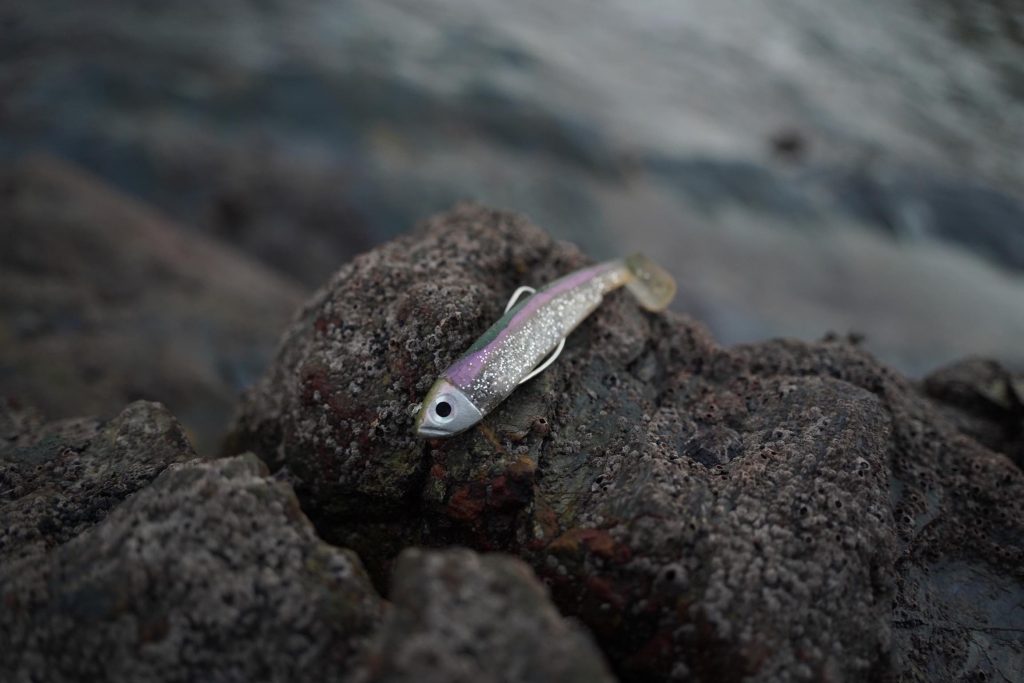
The best bass lure in 2023 is the Fiish Minnow
Let’s consider why the Fiiish Minnow has come to dominate the soft plastics section of many bass anglers’ tackle boxes.
- This lure always has the right sized hook for the body
- It’s easy to rig
- It casts well compared to other soft plastics on jig heads
- It moves in the water so realistically it could fool a human
- It rarely gets snagged due to the weedless design
- It has hyper-realistic colours for a natural presentation
- It’s proven to work on just about any predatory fish, particularly when shore fishing for bass with lures in the UK
- It fishes well OTD, with a straight retrieve, through the kelp, or bounced along an estuary seabed
- It takes seconds to tie one on, and you don’t have to think.
The limitations of the Fiiish Minnow? They are so easy to fish with that it can become tempting to stop experimenting, and that will mean missing out on discovering other effective lure patterns and styles.
They also cannot be suspended and won’t move as naturally in a current as a weightless soft plastic. They’re pretty hard to beat, though. This is the lure to buy if you can afford it and don’t want to think much more about bass lures. We’ve written a review here.
View the Fiish Minnow on Amazon or Veals or Angling Active
Gravity Stick – a weedless weightless paddle tail

The Gravity stick is completely different from the other paddle tails we have looked at. It does not come on a metal jig head that provides weight, not does it have metal inside to provide weight. That is the idea. Instead, it’s made from a heavy plastic and is designed to be fished with a large weedless hook.

On a bass rod rated to 30g and with a good braid, you can still get a good cast with this lure. The Gravity Stick is designed to be fished slowly over very rough ground, perfectly imitating the way baitfish will stay suspended in the water when not moving. Remember those little pollock we mentioned earlier that don’t do much but linger above the kelp? Yeah. Them. When you twitch your rod tip sharply, the tail wags. Otherwise, the lure lingers. The presentation is unlike any other style of soft plastic.
View weedless weightless soft plastic kit – also available on Angling Active
Straight tailed soft plastics

Straight tails are soft lures with tails that aren’t designed to ‘swim’ like a paddle tail or ‘curl’ like a curly tail. “Weedless” is the word for the hooks many bass anglers rig these straight tails on – because it means the hook point is less prone to snagging. As for ‘weightless’ – that refers to the fact that the lure isn’t rigged on a jig head and has no added weight to it, so the lure will sink only very slowly in the water.
Dolive Stick
The Dolive stick and its similar competitors have taken the bass fishing scene by storm. It’s perhaps one of the best bass lures ever made. Rig it weightless with a size 5/0 weedless hook and drift it over the kelp. The lure weighs 12.5g which is far more than most soft plastics (without jig heads). The lure is scented and deadly. The tails can be bitten off by Wrasse but that’s a fairly good problem to have.
Dolive sticks have salt in the lure itself so don’t leave them with hooks rigged until you’re going to use it to avoid rust. They are much more affordable in multipacks from Amazon but are still very much a high-performance lure for anglers using specialist bass rods that cast around 30g or less. With added weight, they can be used on any rod.
What the Dolive stick guys really nailed with this lure was making the soft plastic heavy, so it casts like a dream all on its own. That’s its secret.
Dolive’s are out of stock – but Gravity Sticks are very similar
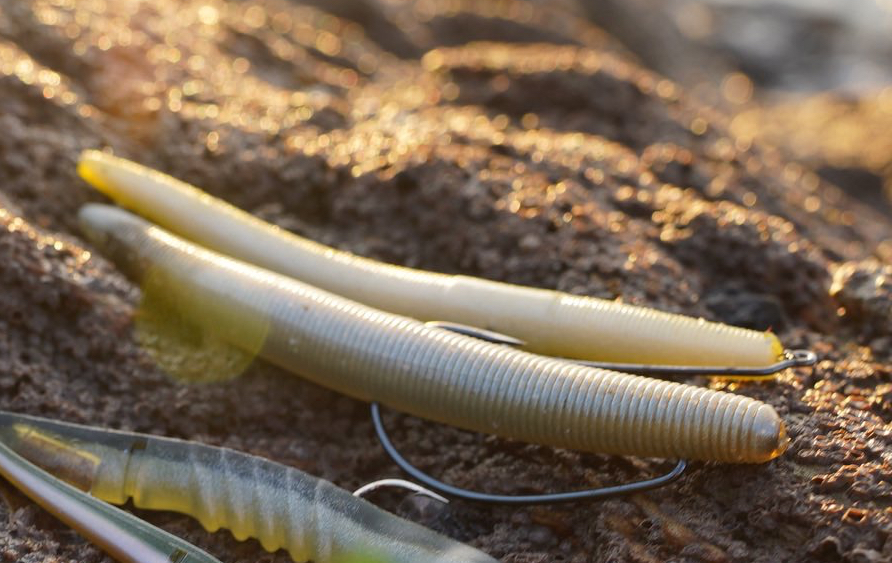
Senko Lures
The 5” Senko was originally designed for the US market. The word Senko means ‘flash’ in Japanese. It was designed to be a twitch bait – a bass lure that is cast out and retrieved with twitching. This works, but it turned out to work best when fished on or near the bottom, with limited movement. This lure is the king of Wrasse lures and works for bass too.
It may look absurd, but its profile is surprisingly similar to that of a sandeel on a steady retrieve, or a lugworm on the seabed, which may explain their effectiveness. Senko lures are very simple to use and rig. It can be rigged on a standard texas rig, or more experimentally, rigged as a whacky rig with no weight at all.

Xlayer / Ultima Stick
This lure’s popularity is in my opinion a mixture of hype and genuine excellence. Let me explain why. It’s been claimed that the ribbed body of the lure creates additional vibrations in the water which help to attract fish. In that vein, it’s also claimed that the internal rattle helps to create noise. I believe the noise makes a difference, particularly for Wrasse – but the ribs? Perhaps it’s made in the same factory they make…
Anyway, the lure has earned its place in the bass lure hall of fame. It works wonders, especially when rock fishing in very rough ground.
One lure type to avoid…
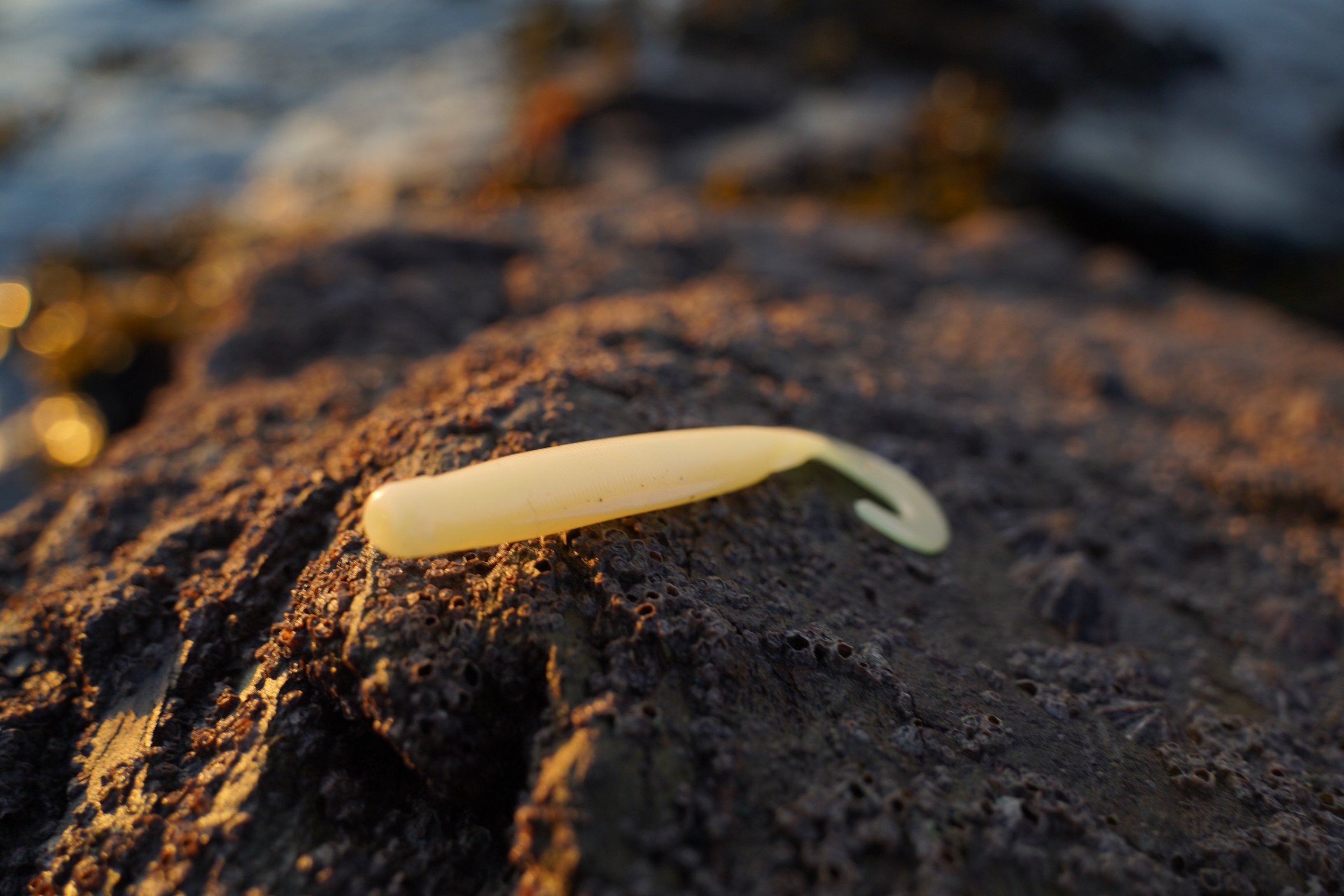
Not many bass anglers reach for curly tails in the UK today. They work well for pollock and other members of the cod family. Bass don’t seem to be fond of them, though. Species like wrasse hit them but often go for the tail, missing the hook.
Let’s move on to the best spinners for bass fishing.
Best bass spinners
What used to be called ‘spinners’ are now often called ‘metals’. These lures cast better than anything else and provide their own weight and are very easy to get fishing with.
Metal lures allow you to fish a lot of ground because they cast so far, and by adjusting your retrieving speed you can determine the depth you fish. This means you can fish a few inches deep over very shallow rough ground if you wish, or easily plump the depths.
I’ve fished with metals a lot and found I don’t catch nearly as many bass as I do with larger soft plastics and hard lures. However, the long-range casting and ability to search out large areas for water is a huge advantage. Many species will hit them, and they are a great generalist staple. Make sure you fish with larger metals. I’ve cast a million LRF metals and caught everything except bass on them.
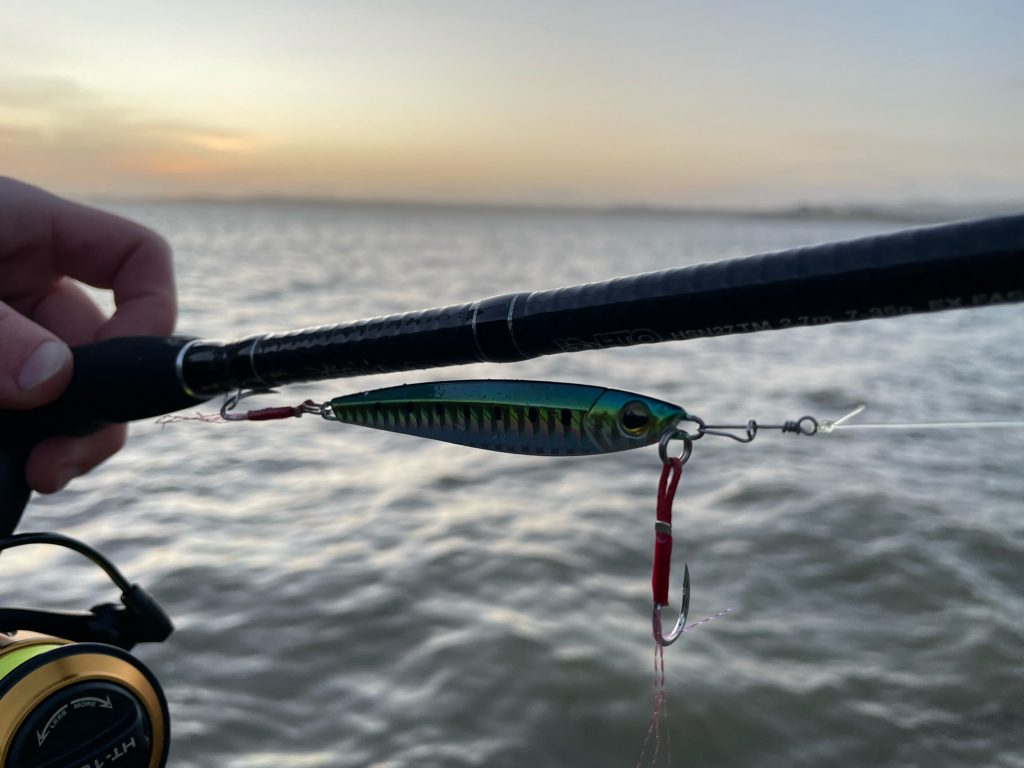
Modern Casting Jigs
Modern casting jigs are designed for jigging, which is the practice of dangling a line directly down the side of a boat and allowing the metal lure to shimmer and spin down the water column, falling vertically below the boat, before lifting your rod and reeling some more before allowing it to fall once again. You can also jig from the shore by using ‘sink and draw’ to allow your lure to fall vertically, before being reeled back in again for a while to repeat the fall once more.
The lure is now used for a much wider range of purposes and is perfect for mackerel fishing. They are not a top choice for bass fishing unless you reach for slow jigs and use them from a boat. They are however great for catching a wide range of species.
The Classic Dexter Wedge
The success of the dexter wedge in decades past was probably due to there being a lot more bass around to catch.
Lures like this have been around forever. Some of the early fishing lures made in the 1600s in Scandinavia were early versions of today’s metals. Metals can be fished in all conditions over any type of ground, provided you keep them higher in the water column over rough ground. In the larger sizes, they are heavy bass lures which cast well on more traditional spinning outfits, which makes them a go-to for those that prefer classic fishing equipment rather than modern lure rods.
You don’t see a huge number of bass anglers raving about this lure today, but it is a staple everybody has in their tackle box and it’s earned its place over decades.
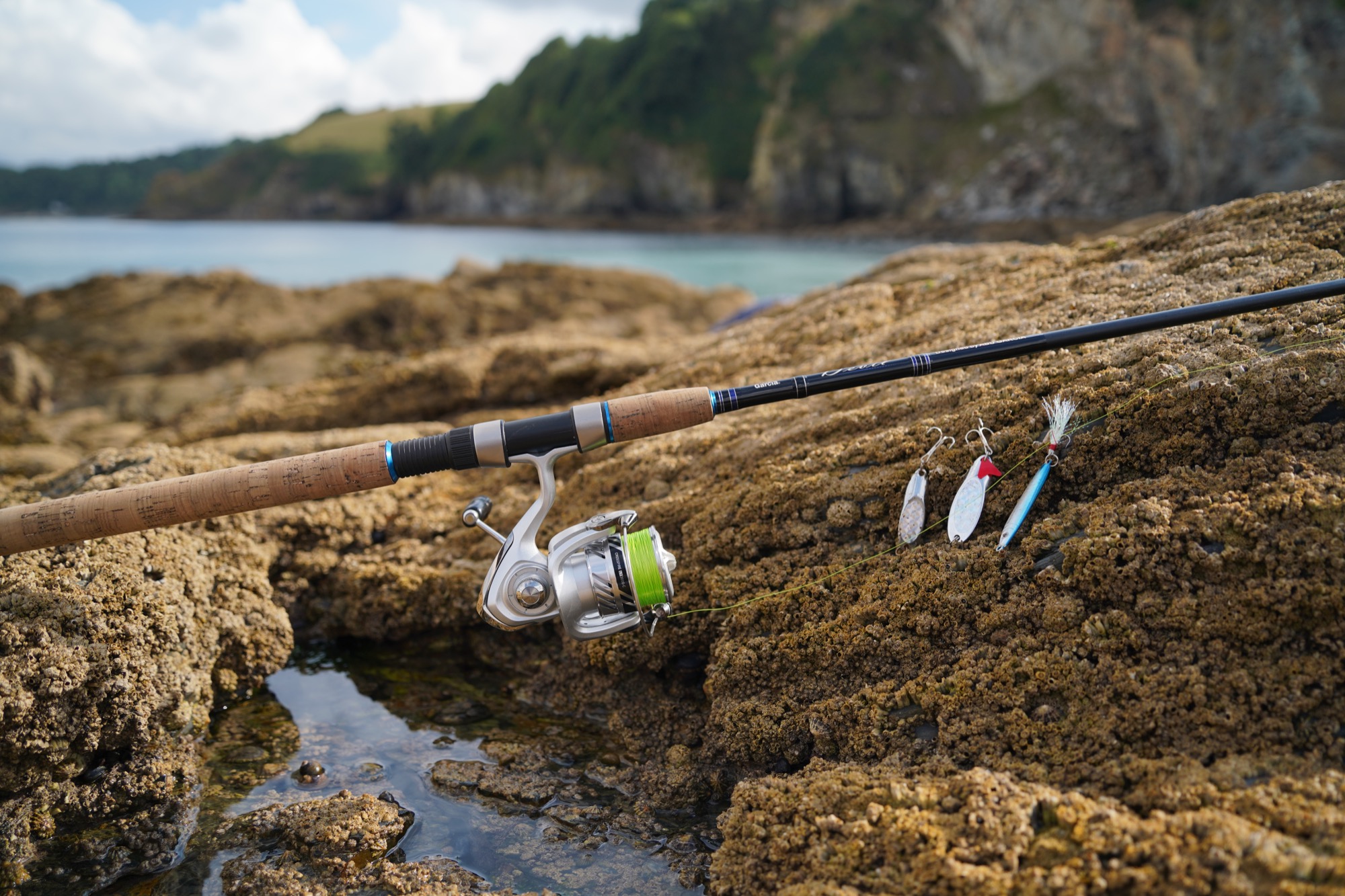
Is the Toby Spoon dead?
Sometimes referred to simply as a ‘toby’, they were designed by Abu Garcia for trout fishing in Scandanavia to imitate the Tobis fish – a little slender minnow.
Due to the larger flat surface of a toby spoon compared to other metal lures, they fall more slowly in the water and create a lot of movement. I suppose they were an early version of today’s advanced slow jigs! The first spoon was developed in the late 17th century, also in Scandanavia. They were different from other lures in that they didn’t really look like fish – and yet were still highly effective. Despite being proven over literally 400+ years, I do not use them. Modern casting jigs are best for our fishing style at FISHMAG, but many love the toby spoon.
Mepps Spinner
Mepps is the old-school angling company from the USA that helped popularised the spinner. The Mepps Aglia spinner has been wildly popular and successful for decades for all kinds of sea fish including bass, despite being developed originally for trout fishing. They are used the world over, based on the assumption that if a predatory fish sees something flashing, spinning and creating a lot of movement, they’re going to hit it.
That theory seems to have worked pretty well, but I would argue some modern lures are much better for bass fishing in the UK. Larger, wiser fish require a better presentation.
If you buy a Mepps spinner, I’d recommend choosing one that provides enough weight that it can be used without adding additional weight.
The 50g version is available here for more traditional bass anglers.
Bass Lure Fishing Q&A
What’s the best colour lure for UK bass fishing?
As of 2022, the UK bass fishing scene has continued its movement towards natural coloured lures. White. Green. Brown. I tend to agree with this, though I think pollack and wrasse are a bit American in that they froth over brightly coloured, absurd-looking lures. Watch out when shopping online for lures that were designed for the US bass market and are being sold in the UK. They often come in bright colours that don’t imitate the fish British bass eat. You of course will have to experiment and work out which colours work best in the area near you, as there may be regional variation based on water clarity and who knows what other factors.
Let’s also not forget that the marine world is insanely colourful – we have orange, red, bright green, and turquoise blue fish in the UK. It’s not entirely absurd to fall for the US bass lures, but it’s not very fashionable at the moment with colours like AYU, silver and white dominating.
Having some long-bodied- silver or white soft plastics is a good idea for fishing the middle and upper sections of the water column, or for fishing in murky water where the white contrasts nicely with a dark backdrop. For fishing deeper around the kelp, more natural colours may bring an advantage, as they more accurately reflect the appearance of the fish you find around the seabed.
Does lure colour matter for sea bass in the UK?
Colour is less important with surface lures because the fish is probably going to see a silhouette anyway. The pattern on the top of your lure is not likely to be visible at all. However, for the sake of natural presentation, silvery white surface lures are popular for imitating injured mackerel, and mullet of lance on the surface. AYU, greens and oranges help imitate pollack, wrasse and other fish that live in the rocks.
What’s the best bass lure colour for murky water?
When the water clarity is poor, many will reach for white lures which contrast more with the darker water around them, and allow your lure to reflect whatever light is present. However, bass can be caught on black lures in murky water on a moonless night, so don’t fret!
What are the best bass lures for summertime UK?
The best lures for bass fishing in the summer are surface lures like the Pachinko. Of course, this is a tongue-in-cheek answer, because there are no specific best bass lures for summer – but this is certainly a very fun way of catching them because in summer bass will hit fry straight off the surface.
Are curly tails good for sea bass?
Soft lures with curly tails used to be very popular – in particular the curly tail jelly eels. These lures have long, wormlike bodies with a curly tail on the end. They were often fished on a texas rig for pollack and wrasse back before the use of soft plastics had really taken off within shore fishing for bass or wrasse in the UK.
I like to use curly tails for pollack fishing (and Perch) and that’s it. I don’t use them for bass fishing and don’t find them particularly effective for either wrasse or bass. I believe the curly tail actually freaks out a lot of bass unless they’re really on the feed. The curly tail is often bitten off by wrasse, acting as a distraction from the body of the lure where your hook lies.
What size hook is best for bass fishing UK?
A decent rule is to use a hook one size less than the length of the lure in inches. For instance. The cutoff points with this rule are size 3/0 and size 6/0. Much smaller weedless hooks are better for wrasse or LRF fishing, but this guide is exclusively dealing with bass which have huge mouths. If you were keen on catching wrasse in the same session, smaller (barbless) hooks would help.
4” lures go well with size 3/0 weedless hooks
5” lures go well with 4/0 weedless hooks
6” lures go well with size 5/0 weedless hooks
Or, you can just buy a very good value pack of Momolures ‘Dolive stick’ inspired lures which come with weighted and unweighted weedless hooks of the correct size for bass.
What are the best bass lures for winter in the UK?
If you’re brave enough to target bass in a UK winter, straight tail lures are your best bet. When the water is colder and life is less abundant and the metabolisms of bass have slowed down, their feeding behaviour will also slow. They will stop chasing fry all over the place, like a shoal of hungry mackerel, and start behaving wiser, looking not just for food – but for the easiest meals possible.
In winter you may be better off targeting the cousin of the bass – the freshwater perch. But if you insist, then use straight-tailed soft lures and fish closer to the sea bed much more slowly than you would in the warmer months. This is also useful for fishing for bass in Spring.
What is the best sea bass lure for shore fishing in the UK?
The best bass lure for shore fishing in the UK is probably a weedless paddle tail weighted to about 21g or 2/3rds of one ounce. This will enable you to fish over the widest variety of types of ground without getting in snags, casts very easily and does not break the bank in the same way hard lures can!
What is the best bass lure for boat fishing in the UK?
The most popular bass lure for boat fishing in the UK is a larger paddle-tailed lure with a higher weighting so it falls down the water column faster. For instance, an offshore soft plastic like the Fiiish Minnow offshore is ideal. Another popular option is a sidewinder, which isn’t weedless so is liable to get snagged on reefs and wrecks but costs less.
US Bass Lures vs UK Bass Lures
As a very general rule if you’re looking for bass lures and are shopping for US-style lures, look out for plugs with longer bodies and check how deep they dive. A lot of lures marketed as being for sea bass online are actually made primarily for freshwater bass and won’t be that effective. There will be some absolute gems you could discover if you put in the hours. I myself would like to experiment with a popper fly.
Surf fishing for big bass | Grant Woodgate
Surf fishing for big bass with Samson Lures | Masterclass with Grant Woodgate Few people…
The best braided fishing lines, ranked
The best braided fishing lines, ranked We look at the best braids, from the budget…
The best bass rods | Finding your next stick
The best bass rods | Finding your next stick The most common bass fishing setup…
The Ideal Lure Fishing Set-Up
Lure fishing set ups, everything you need. In this article, I will recommend specific rods,…
Rock Fishing with Lures
Rock Fishing with Lures You’re sat, perching on a rock below a colony of cormorants….
Lure Fishing UK | Beginners Guide
Lure Fishing UK | Beginners Guide This guide to lure fishing for beginners covers the…

